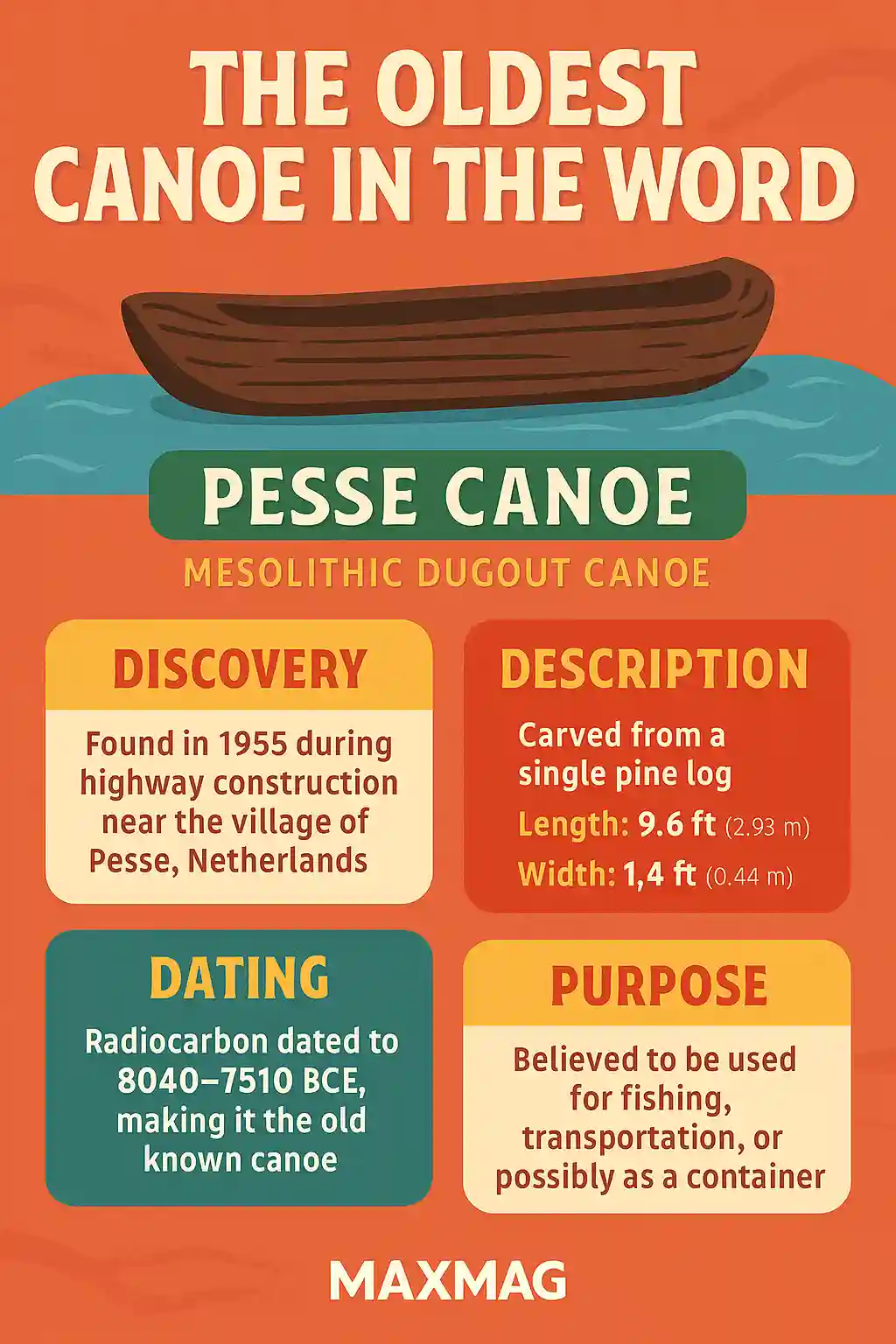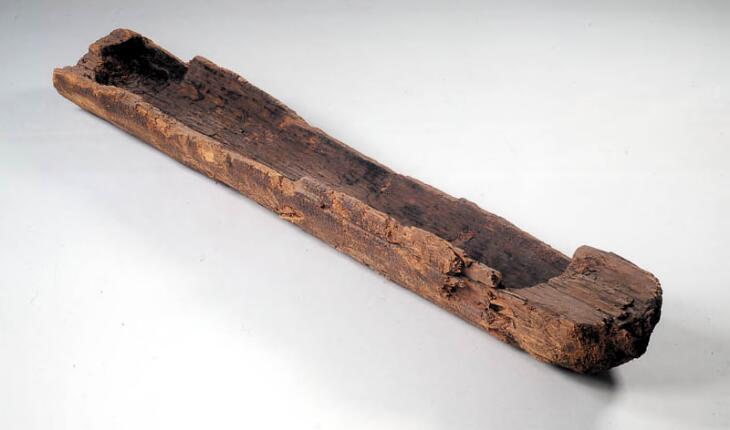
When we think about human innovation, we often imagine fire, the wheel, or the first tools. But one of the most quietly revolutionary inventions was the boat. Long before the printing press or metalworking, humans were carving vessels to glide across rivers and lakes. One such marvel, the oldest canoe in the world, is not just a wooden relic—it’s a doorway into the minds and needs of early humans.
This article explores the story behind the Pesse canoe, a Mesolithic-era artifact discovered in the Netherlands that still challenges our understanding of technology and survival nearly 10,000 years ago.
A Glimpse Into Prehistory: What Is the Pesse Canoe?
Unearthed in the 1950s during roadwork in the Dutch town of Pesse, this ancient dugout canoe dates to somewhere between 8040 and 7510 BCE. That timeline places it right at the dawn of the Mesolithic period, a time when Europe was just beginning to thaw from the last Ice Age.
At just under 10 feet long and made from a single hollowed-out pine log, the Pesse canoe might not look impressive at first glance. But archaeologists quickly recognized it as something extraordinary—the oldest canoe in the world ever discovered in usable form.
While scholars initially debated its use, modern reconstructions and tests have shown that it was indeed seaworthy. Its narrow frame and shallow draft made it ideal for lakes and rivers, likely used for fishing or short-distance travel.
Digging Deeper: How Was the Canoe Made?
Without metal tools or machinery, Mesolithic peoples relied on persistence, ingenuity, and what nature provided. The canoe was carved with hand tools fashioned from sharpened stone and animal bone—likely using fire to soften the wood, then scraping it out over days or weeks.
The craftsmanship required to balance depth, width, and buoyancy was nothing short of masterful. This was no random log; it was a carefully engineered vessel—proving that even 10,000 years ago, humans were problem solvers and tinkerers.
Why It Matters: Not Just the Oldest Canoe in the World
What makes the Pesse canoe more than just a historical curiosity is its significance to human development. It represents:
-
Early transportation ingenuity: Before wheels or roads, rivers were our highways.
-
Resource adaptability: Turning a tree into a tool of survival showcases how early humans used what they had with precision.
-
Cultural evolution: The very act of building a canoe implies trade, travel, or spiritual movement—suggesting community and foresight.
For an excellent example of how cultural advancements interlink with daily life in antiquity, take a look at this related MaxMag article on ancient mystery satchels.

The Controversy: Was It Really a Canoe?
When the canoe was first studied, some skeptics thought it might have been a feeding trough or even a tree trunk hollowed out by accident. But that changed in the early 2000s when archaeologists built a replica and tested it in the water. It floated. It steered. It carried people. The experiment confirmed what intuition had long suspected—the Pesse artifact was, in fact, the oldest canoe in the world.
Such reconstructions are an essential part of experimental archaeology, a hands-on science that helps researchers test historical hypotheses through real-world practice. The University of Washington’s Department of Anthropology offers deep insight into these modern archaeological methods.
Comparing Ancient Watercraft
While the Pesse canoe holds the crown for age, it’s not alone. Other early dugouts have been found in Africa, Asia, and the Americas. One famous example is the Dufuna canoe in Nigeria, dated around 8000 years ago. Though younger, its similar construction shows that people in vastly different environments were independently developing water transport.
But none predate the Dutch find. For now, the Pesse canoe stands as the benchmark, the verified oldest canoe in the world.
Where to See It Today
The Pesse canoe now resides at the Drents Museum in Assen, Netherlands. It’s displayed under controlled conditions to preserve its fragile wooden structure, and remains one of the museum’s most visited artifacts.
Those curious about the global history of ancient boats can also explore the National Museum of the American Indian in Washington, D.C., where traditional dugouts and birchbark canoes demonstrate how early watercraft evolved over time and geography.
How the Canoe Shaped Human Life
Before roads, roads were rivers. The oldest canoe in the world is more than an object—it’s a reminder that water was a force humans learned to tame. With boats, we fished more efficiently, connected with other tribes, migrated, and traded. The canoe was a catalyst for civilization’s expansion.
It’s no exaggeration to say that, without vessels like the Pesse canoe, human history might have floated in a very different direction.
Frequently Asked Questions
What is the Pesse canoe?
It’s a hollowed-out pine log canoe found in the Netherlands, dated between 8040–7510 BCE, considered the oldest surviving canoe in the world.
How was it preserved so well?
The canoe was buried in a peat bog, where oxygen levels are low and organic materials like wood are less likely to rot.
What was it used for?
Most likely for short water journeys or fishing, given its narrow shape and size.
Can I visit the Pesse canoe?
Yes, it’s on display at the Drents Museum in Assen, Netherlands.
Have older boats been found?
No wooden boat older than the Pesse canoe has been discovered in a confirmed, usable condition.
Why is it important today?
It helps archaeologists understand early technology, lifestyle, and the importance of water in ancient survival strategies.
Conclusion
The Pesse canoe isn’t just the oldest canoe in the world. It’s a symbol of what humans are capable of when they combine curiosity with craftsmanship. From the moment someone carved that pine log, a new chapter in human mobility began.
We often talk about human evolution in terms of brains, tools, or language. But watercraft like the Pesse canoe remind us that our journey also unfolded across rivers and lakes—where logs became lifelines and travel began with trust in the water beneath our feet.




